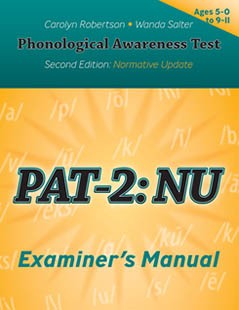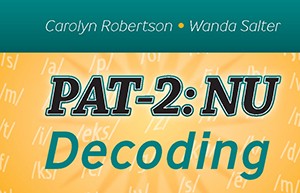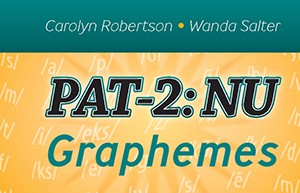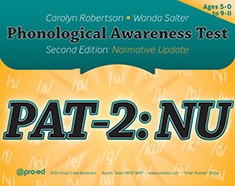Phonological Awareness Test 2: Normative Update (PAT-2: NU)
COMPLETE KIT
- Ages 5 - 9 years
- Testing Time 40 - 50 minutes
- Administration Individual
-
Product Code 34350 ( MR #066621 )
* Qualifications required to purchase this item. Click here to complete the qualifications form.
 *Contains small parts that may be a choking hazard for children under the age of 3.
*Contains small parts that may be a choking hazard for children under the age of 3.
Price $248.00
Contents
-

Phonological Awareness Test 2: Normative Update (PAT-2: NU)
PAT-2: NU Examiner's Manual
$104.00 -

Phonological Awareness Test 2: Normative Update (PAT-2: NU)
PAT-2: NU Examiner Record Booklets (25)
$54.00 -

Phonological Awareness Test 2: Normative Update (PAT-2: NU)
PAT-2: NU Phoneme Decoding Stimuli Booklet
$47.00 -

Phonological Awareness Test 2: Normative Update (PAT-2: NU)
PAT-2: NU Grapheme Correspondence Stimuli Booklet
$37.00 -

Phonological Awareness Test 2: Normative Update (PAT-2: NU)
PAT-2: NU Coloured Blocks
$9.60
- Rhyming: Discrimination and Production—identify rhyming pairs and provide a rhyming word
- Segmentation: Sentences, Syllables, and Phonemes—divide by words, syllables, and phonemes
- Isolation: Initial, Final, and Medial—identity sound position in words
- Deletion: Compound Words, Syllables, and Phonemes—manipulate root words, syllables, and phonemes in words
- Substitution with Manipulatives—isolate a phoneme in a word, then change in to another phoneme to form a new word
- Blending: Syllables and Phonemes—blend units of sound to form new words
- Phoneme-Grapheme Correspondence—assesses knowledge of sound/symbol correspondence for consonants, vowels, consonant blends, consonant digraphs, r-controlled vowels, vowel diagraphs, and diphthongs
- Phonemic Decoding—assess general knowledge of sound/symbol correspondence to blend sounds into nonsense words
- Characteristics of the normative sample were stratified by age relative to region, gender, ethnicity, and socioeconomic factors, and other critical variables are the same as those reported for the school-age population reported the Statistical Abstract of the United States 2016 (ProQuest, LLC, 2016).
- Each item on the test was evaluated using both conventional item analysis to choose “good” items and differential analyses to find and eliminate potentially biased items.
- The subtests and composite scores were thoroughly examined for floor and ceiling effects.
- Criterion-prediction validity is evidenced by correlations with, and comparison of mean and standard deviations of, the CTOPP-2 Phonological Awareness Composite Score.
- New normative scores for the subtests were calculated in terms of scaled scores that have a mean of 10 and a standard deviation of 3.
- The Total Score was divided into the Phonological Awareness Index and the Phoneme-Grapheme Index. These scores are calculated as composite scores (another type of standard score) with a mean of 100 and a standard deviation of 15. The composites reflect direct linear transformations of the sums of scaled scores and give equal weight to each of the subtests that comprise the Phonological Awareness Index and Phoneme-Grapheme Index.
- The Examiner’s Manual was reorganized and rewritten to provide more detailed information on the administration, interpretation, and statistical characteristics of the test.
-

Phonological Awareness Test 2: Normative Update (PAT-2: NU)
PAT-2: NU Examiner's Manual
$104.00 -

Phonological Awareness Test 2: Normative Update (PAT-2: NU)
PAT-2: NU Examiner Record Booklets (25)
$54.00 -

Phonological Awareness Test 2: Normative Update (PAT-2: NU)
PAT-2: NU Phoneme Decoding Stimuli Booklet
$47.00 -

Phonological Awareness Test 2: Normative Update (PAT-2: NU)
PAT-2: NU Grapheme Correspondence Stimuli Booklet
$37.00 -

Phonological Awareness Test 2: Normative Update (PAT-2: NU)
PAT-2: NU Coloured Blocks
$9.60
- Copyright 2018

 Proud to be Canadian
Proud to be Canadian